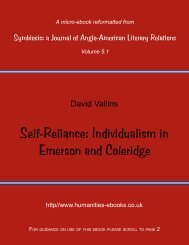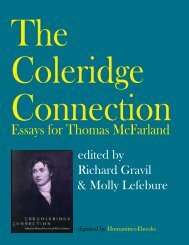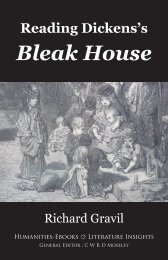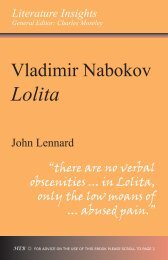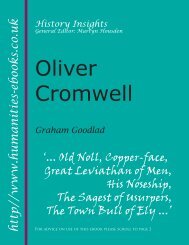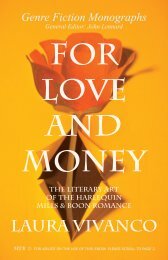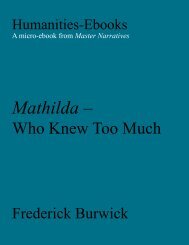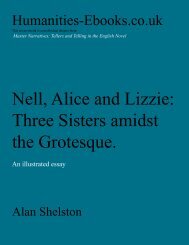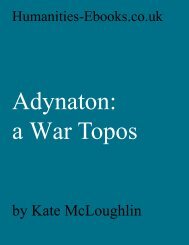William Shakespeare - Humanities-Ebooks
William Shakespeare - Humanities-Ebooks
William Shakespeare - Humanities-Ebooks
Create successful ePaper yourself
Turn your PDF publications into a flip-book with our unique Google optimized e-Paper software.
http//www.humanities-ebooks.co.uk<br />
Literature Insights<br />
General Editor: Charles Moseley<br />
<strong>William</strong> <strong>Shakespeare</strong><br />
Hamlet<br />
John Lennard<br />
‘The final<br />
testimony<br />
to <strong>Shakespeare</strong>’s<br />
generosity is how<br />
much he leaves up<br />
to the actors’
Publication Data<br />
© John Lennard, 2007<br />
The Author has asserted his right to be identified as the author of this Work<br />
in accordance with the Copyright, Designs and Patents Act 1988.<br />
Published by <strong>Humanities</strong>-<strong>Ebooks</strong>.co.uk<br />
Tirril Hall, Tirril, Penrith CA10 2JE<br />
Reading Options<br />
* To use the navigation tools, the search facility, and other features of the<br />
Adobe toolbar, this Ebook should be read in default view.<br />
* To navigate through the contents use the hyperlinked ‘Bookmarks’ at<br />
the left of the screen.<br />
* To search, expand the search column at the right of the screen or click<br />
on the binocular symbol in the toolbar.<br />
* For ease of reading, use to enlarge the page to full screen<br />
* Use to return to the full menu.<br />
* Hyperlinks appear in Blue Underlined Text.<br />
Licence and permissions<br />
Purchasing this book licenses you to read this work on-screen and to print<br />
one copy for your own use. Copy and paste functions are disabled. No part<br />
of this publication may be otherwise reproduced or transmitted or distributed<br />
without the prior written permission of both the copyright owner and the publisher.<br />
Making or distributing copies of this book constitutes copyright infringement<br />
and would be liable to prosecution. Thank you for respecting the rights<br />
of the author.<br />
ISBN 978-1-84760-028-8
<strong>William</strong> <strong>Shakespeare</strong>: Hamlet<br />
John Lennard<br />
Literature Insights. Tirril: <strong>Humanities</strong>-<strong>Ebooks</strong>, 2007
A Note on the Author<br />
John Lennard took his B.A. and D.Phil. at Oxford University, and his M.A. at Washington<br />
University in St Louis. He has taught in the Universities of London, Cambridge, and<br />
Notre Dame, and for the Open University, and is now Professor of British & American<br />
Literature at the University of the West Indies—Mona. His publications include But I<br />
Digress: The Exploitation of Parentheses in English Printed Verse (Clarendon Press,<br />
1991), The Poetry Handbook (1996; 2/e, OUP, 2005), and with Mary Luckhurst The<br />
Drama Handbook (OUP, 2002). He is the general editor of the Genre Fiction Sightlines<br />
and Monographs series, and has written Sightlines on works by Reginald Hill,<br />
Walter Mosley, Octavia E. Butler, and Ian McDonald. His critical collection Of Serial<br />
readers and other essays on genre fiction (2007), published simultaneously with this<br />
e-book, launches the Monographs Series.
Contents<br />
A Note on the Author<br />
Preface<br />
A note on the texts of Hamlet<br />
Acts and scenes in the Arden 3 Q2 Hamlet<br />
Part 1. Approaching <strong>Shakespeare</strong><br />
1.1 A Man of the Jacobethan Theatre<br />
1.2 Companies—Actors—Stages—Audiences<br />
1.3 Venus and Lucrece<br />
1.4 Errors and Two Gentlemen<br />
Part 2. Approaching Hamlet<br />
2.1 Revenge with Complications<br />
2.2 A Play by <strong>Shakespeare</strong><br />
Part 3. Actors and Players<br />
3.1 Old Hamlet / the Ghost<br />
3.2 Horatio<br />
3.3 Claudius<br />
3.4 Gertrude<br />
3.5 Polonius<br />
3.6 Laertes<br />
3.7 Ophelia<br />
3.8 Rosencrantz & Guildenstern<br />
3.9 The gravediggers<br />
3.10 Osric<br />
3.11 Fortinbras<br />
3.12 Hamlet<br />
3.13 “The best players in the world”
Part 4. Acts and Devices<br />
4.1 Acts<br />
4.2 Scenes<br />
4.3 Soliloquy and Colloquy<br />
4.4 Verse, Prose, and Song<br />
4.5 Metatheatre<br />
4.6 Doubling<br />
4.7 Special Effects<br />
4.8 Exits<br />
Part 5. Hamlet and Twelfth Night<br />
Part 6. Critics’ Corner<br />
6.1 Bibliography<br />
6.2 Web-sites<br />
Hyperlinked Materials<br />
serious doubt<br />
theatre-space<br />
breath-length<br />
discovery-space<br />
comedic and tragedic modes<br />
Vice<br />
Inconclusive<br />
Speculation<br />
Blackfriars<br />
Ciceronian periods
Preface<br />
Like much in the modern world, Hamlet has acquired a tendency to become obese. In<br />
the Arden 2 <strong>Shakespeare</strong>, Harold Jenkins’s edition was twice the width of every other<br />
play; in Arden 3, Ann Thompson’s and Neil Taylor’s edition is in two volumes, jointly<br />
twice as wide as Jenkins’s one, and such remorseless bulking is an unhappy trend.<br />
The play can also expand in performance: a fine 2001 Royal <strong>Shakespeare</strong> Company<br />
(RSC) stage-production (directed by Steven Pimlott and starring Sam West) ran over<br />
four hours with two intervals, and Kenneth Branagh’s 1996 film-adaptation, lasting<br />
a whopping 242 minutes, is rarely watched from start to finish, especially in one go.<br />
Still more off-puttingly for students, Hamlet criticism has the same expansiveness.<br />
This Literature Insight is determinedly short. Great need not mean ponderous,<br />
and on stage Hamlet (like most <strong>Shakespeare</strong>) almost always does better at a brisk<br />
canter than a solemn march. In dealing with something as complex as the world’s<br />
premier Early Modern tragedy simplicity is not always useful; straightforwardness<br />
and cogency almost always are, so scholarly problems are ruthlessly relegated to<br />
references, while links in the bibliography make available to interested readers the<br />
primary materials, that they may see for themselves what the evidence supports.<br />
Casting matters are trickier, for there is almost no evidence about the first casting of<br />
any of <strong>Shakespeare</strong>’s plays, and most of what is said is pure speculation. But someone<br />
first played each role, and a pool of most probable names is known: so the game<br />
can be compulsive. It is in no way necessary, but a grasp of the practical necessities<br />
and constraints <strong>Shakespeare</strong> faced in writing (which for a working playwright of his<br />
kind means casting) is very helpful, and inevitably brings more speculative territory<br />
into view. So sometimes I speculate, but only in footnotes or link-text, and in Part 6,<br />
where it is properly flagged and discussion can be as careful as it need.<br />
Plot-summaries etc. are widely available, so I assume readers have read Hamlet<br />
at least once and know what happens. The only special thing readers—particularly<br />
those without theatrical experience—are asked to do is to think seriously about the<br />
<br />
<br />
There have been three series of Arden editions: the second appeared 1946–82, the third began to<br />
appear in 1993.<br />
‘Early Modern’: for historians, the period 1500–1700; ‘Modern’ = 1700–present.
Hamlet <br />
business of acting in a particular space. If possible, visit a theatre, any theatre, sit,<br />
breathe, look, and absorb its design. Follow these links to images of a classical<br />
amphitheatre, Roman stage, pageant-wagon, and Elizabethan amphitheatre, <br />
and just look at each hard for a minute. <strong>Shakespeare</strong>’s Hamlet has over four centuries<br />
been done in, on, and round about all of them, and many stranger venues besides, <br />
and no performance is ever independent of the physical and institutional structures<br />
that enable and frame it—buildings, stages, actors, and audiences. If these things are<br />
missing from your imagined understanding of the play’s text/s, it will (rightly) seem<br />
to you as lifeless as a TV without power; but turn the current on …<br />
A note on the texts of Hamlet<br />
There are three ‘early texts’ of Hamlet: Q1 (1603), the so-called ‘Bad Quarto’, which<br />
at c.2000 lines is half the length of the others and very different; Q2 (1604), the<br />
‘Good Quarto’ of c.3700 lines; and F (1623), the ‘Folio text’ of c.3550 lines from the<br />
first collected <strong>Shakespeare</strong>, which drops c.230 of Q2’s lines, adds c.70 of its own, and<br />
(slightly) changes many more. Since the nineteenth century there has also been an<br />
‘eclectic’ or ‘composite’ text of c.3850 lines, generated by editors who combine all<br />
lines in Q2 and F with some lines and stage-directions from Q1. <br />
My references are to the Arden 3 Hamlet edited by Ann Thompson & Neil Taylor<br />
(2 vols, London: Thompson Learning, 2006), and usually to its (modernised) Q2 text<br />
(in vol. 1); when the Q1 or F texts (in vol. 2) are cited, the reference indicates this.<br />
I have also therefore followed the scene-numbering and act-division of the Arden 3<br />
text; in other editions 1.4–5 may be combined, as may any of 4.1–4 (which in F form<br />
3.5–7). For ease of reference a summary of Arden 3’s acts and scenes is given below.<br />
All other <strong>Shakespeare</strong>an references are to the Riverside text, 2 nd edition, 1997.<br />
Readers are reminded that lines per scene and role vary with editions, and that<br />
‘verse-lines’ (i.e. complete iambic pentameters) divided between two or three speakers<br />
may count in two or three roles—so totals may seem not to tally. All line-counts<br />
given are my own, and derive from the Arden 3 Q2 text.<br />
External Hyperlinks appear in blue + underline; internal hyperlinks also have the symbol ►.<br />
Including a ship in 1607: see http://www.as.ua.edu/english/strode/articles/taylor/hamlet3.htm<br />
For a longer discussion of <strong>Shakespeare</strong>an editing, using Hamlet 5.1 as an example, see John<br />
Lennard & Mary Luckhurst, The Drama Handbook (Oxford: Oxford University Press, 2002), ch. 3.<br />
Line-counts cannot be absolute because methods of counting stage-directions, headings, blank<br />
lines, and part-lines that are or end complete speeches vary.
Hamlet <br />
Acts and scenes in the Arden 3 Q2 Hamlet<br />
Act 1<br />
Scene 1: Barnardo, Francisco, Marcellus, Horatio, Ghost<br />
Scene 2: Claudius, Gertrude, Voltemand, Cornelius, Polonius, Laertes, Hamlet<br />
(O that this too too sallied flesh), Horatio, Barnardo*, Marcellus<br />
Scene 3: Laertes, Ophelia, Polonius<br />
Scene 4: Horatio, Marcellus, Hamlet, Ghost<br />
Scene 5: Hamlet, Ghost, Horatio, Marcellus*<br />
Act 2<br />
Scene 1: Polonius, Reynaldo*, Ophelia<br />
Scene 2: Claudius, Gertrude, Rosencrantz, Guildenstern, Voltemand*,<br />
Cornelius*, Polonius, Hamlet (O, what a rogue …), Players<br />
Act 3<br />
Scene 1: Claudius, Gertrude, Rosencrantz, Guildenstern, Polonius, Ophelia,<br />
Hamlet (To be, or not to be)<br />
Scene 2: Claudius, Gertrude, Rosencrantz, Guildenstern, Polonius, Ophelia,<br />
Hamlet, Horatio, Players*<br />
Scene 3: Claudius, Rosencrantz, Guildenstern, Polonius, Hamlet<br />
Scene 4: Gertrude, Polonius†, Hamlet, Ghost* (‘closet scene’)<br />
Act 4<br />
Scene 1: Claudius, Gertrude, Rosencrantz, Guildenstern<br />
Scene 2: Hamlet, Rosencrantz, Guildenstern<br />
Scene 3: Claudius, Rosencrantz, Guildenstern, Hamlet<br />
Scene 4: Fortinbras, Captain*, Rosencrantz*, Guildenstern*, Hamlet (How all<br />
occasions do inform …)<br />
Scene 5: Gertrude, Gentleman, Horatio, Ophelia*, Claudius, Messenger, Laertes<br />
(‘mad scene’)<br />
Scene 6: Horatio, Gentleman*, Sailors*<br />
Scene 7: Claudius, Laertes, Messenger*, Gertrude (There is a willow …)<br />
Act 5<br />
Scene 1: Gravediggers*, Hamlet, Horatio, Claudius, Gertrude, Laertes, Priest*<br />
Scene 2: Hamlet†, Horatio, Osric, Claudius†, Gertrude†, Laertes†, Fortinbras<br />
* last appearance † dies
Part 1. Approaching <strong>Shakespeare</strong><br />
1.1 A Man of the Jacobethan Theatre<br />
The basic facts of <strong>William</strong> <strong>Shakespeare</strong>’s life—birth in 1564, education at Stratford<br />
Grammar, marriage to Anne Hathaway (1556–1623), children, work, death in 1616—<br />
are perfectly clear and without serious doubt ►; but detail of any kind is almost nonexistent,<br />
and what there is is dubious or unhelpful. For a man born in the mid-sixteenth<br />
century this is already a notably full record—<strong>Shakespeare</strong> has attracted millions of<br />
hours of research, and Early Modern English records are better than most—but there<br />
is, blazingly, one thing more: that <strong>Shakespeare</strong>’s central passion, occupation, art, and<br />
craft was the Jacobethan theatre, dominantly the public amphitheatres. As actor,<br />
sharer, and resident dramatist of the Lord Chamberlain’s / King’s Men he was a<br />
major player in a particular emergent art, craft, and trade about which much is known<br />
and more can be inferred.<br />
A basic problem in imagining the Jacobethan theatre is that the closure of all<br />
English theatres from 1642–60 severed professional continuity; theatres built after<br />
1660 were strongly influenced by continental European models dominated by perspectival<br />
scenery—quite different from the London amphitheatres of <strong>Shakespeare</strong>’s<br />
day. All older English plays struggled after 1660, losing as much as gaining in being<br />
forcibly adapted for and into the new theatre—a change bluntly recorded in the shift<br />
from going, as Elizabethans did, to hear a play, as auditors in an audience, to going<br />
(as we still do) to see a play, as spectators of something we hope will be spectacular.<br />
Susanna, 1583–1649; fraternal twins Hamnet, 1585–96, and Judith, 1585–1662.<br />
‘Jacobethan’: a portmanteau of Elizabethan (in the reign of Elizabeth I, 1558–1603) and Jacobean<br />
(James VI & I, 1603–25), used because <strong>Shakespeare</strong>’s working life straddles the reigns.<br />
‘Sharer’: Like partners in a modern professional practice, sharers invested a substantial sum to buy<br />
their share, entitling them to a percentage of net receipts. There were eight sharers in <strong>Shakespeare</strong>’s<br />
company who probably played larger roles in most plays, while minor ones were played by hired<br />
men.<br />
‘Lord Chamberlain’s’ / ‘King’s Men’: Under Elizabeth, the official patron of the company to which<br />
<strong>Shakespeare</strong> belonged was from 1594 the Lord Chamberlain, so they were the ‘Lord Chamberlain’s<br />
Men’; after 1603 King James assumed that role himself, so the company became the ‘King’s<br />
Men’.
Hamlet 11<br />
So there has since 1660 been a particular sensory and intellectual gap, and to meet<br />
<strong>Shakespeare</strong> on his own ground (where he makes fullest, most immediate sense)<br />
modern readers must be aware of auditing as well as spectating, and of the theatreworld<br />
that supported <strong>Shakespeare</strong>’s full, passionate, and successful career.<br />
Perhaps the most obvious thing about that theatre-world is its energy. London was<br />
buzzing, and throughout <strong>Shakespeare</strong>’s career (c.1590–1613) remained the largest,<br />
most innovative city in Europe. Trade, war, expansion, investment—and new ways<br />
of investing—were powerful drivers. England as a whole had also forcibly stopped<br />
an activity that had long been important, and the impulses it had satisfied needed<br />
a new outlet. Under Roman Catholicism theatre was sacred: mystery cycles were<br />
performed in public procession at their time in the liturgical round, while morality<br />
plays taught doctrine and miracle plays celebrated exemplary lives. Many people<br />
acted and very many more audited, so when Henry VIII broke with Rome in 1533 he<br />
couldn’t simply suppress traditions of sacred performance—but the Catholic doctrine<br />
and faith they celebrated could only be a problem for an Anglican monarch, so the<br />
weight slowly came on, and there is no known English performance of a complete<br />
cycle after Coventry in 1574.<br />
That date should give pause, for the mystery cycles and morality plays are often<br />
firmly labelled as mediaeval, as they are in origin—but they were performed into<br />
<strong>Shakespeare</strong>’s lifetime, and he certainly knew about them. Just as importantly, many<br />
people he spoke to, worked with, and wrote for were also familiar with the cycles<br />
and their performance: but in 1575 the cycles were no more, and theatre will out.<br />
The man with the good timing, right idea, and persuasive tongue was James Burbage<br />
(d.1597), and the idea he had was in all fundamentals the modern theatre. What may<br />
most surprise is just how original an idea it was.<br />
Greek theatre, like the mystery cycles, was sacred and classical amphitheatres<br />
part of temple-complexes, while Roman theatre was mostly political, usually a poor<br />
relation of gladiatorial sports, and always a matter of direct patronage and official<br />
subsidy. Travelling players in the middle ages have left no trace of any permanent<br />
stages, so what Burbage wanted in 1576 was radical: a large, purpose-built structure<br />
owned and run by professional actors, to be funded through commercial performances.<br />
Preconditions for such a venture include a sufficiently large and wealthy catchment<br />
area, a workable design for the building, a pool of (would-be) actors, writers able to<br />
<br />
The ‘porter’ scene in Macbeth (2.3) is based on the ‘Harrowing of Hell’ in the mystery cycles,<br />
when ‘devil-porters’ are disturbed by Jesus hammering on the gates—but the specificity of this<br />
well-known example tends to mask rather than emblematise the far wider and deeper connection<br />
between the ‘mysteries and moralities (d.1574)’ and the ‘<strong>Shakespeare</strong>an Stage (b.1576)’.
Hamlet 12<br />
supply a stream of new plays, a team to handle production, finance, and the public<br />
once admitted, the blessings of central government and local authority, and a financier<br />
willing to lend you a very large sum on the strength of these plans … but Burbage<br />
pulled it off, and built in Shoreditch, just east of the City of London, what was simply<br />
called The Theatre.<br />
It had to be outside the City wall because the City Fathers had religious beliefs<br />
(and social convictions) that led them to disapprove of theatre in all forms, but even in<br />
Shoreditch other restrictions applied. A great show-woman herself, Queen Elizabeth<br />
knew very well just what theatricality could achieve politically, and plays for public<br />
performance had to be licensed by her Master of the Revels; offenders could and did<br />
find themselves in prison for a month or three, and any playwright venturing towards<br />
religion or recognisably current politics did so at their (and the actors’) peril. But it all<br />
worked! Within two years a second theatre, The Curtain, was providing competition,<br />
and the 1580s saw steady growth, however measured, so by the time <strong>Shakespeare</strong><br />
came to London, probably in the later 1580s, the stage was in every way set for him.<br />
A body of actors had emerged for whom increasingly talented and professionally<br />
assured playwrights were beginning to write great roles, and company structures had<br />
been created that for the sharers were beginning to produce real wealth. Above all,<br />
Londoners had taken to the new entertainment in a big way, and the acting profession,<br />
despite its perennial insecurities, was already entrenched in popular and elite cultures.<br />
That was the working world <strong>Shakespeare</strong> entered, and as sharer-playwright of the<br />
premier company from 1594–1613 bestrode.<br />
1.2 Companies—Actors—Stages—Audiences<br />
Theatre is always, of necessity, a practical group business. When it is also putting<br />
food on the actors’ tables, and must finance a building as well as covering the initial<br />
and running costs of performance, there is no room for mavericks or spendthrifts—yet<br />
much about theatre seems to attract, and worse to need and benefit from, people with<br />
exactly those qualities. The main answer to this conundrum in <strong>Shakespeare</strong>’s day was<br />
the company, a professional business in which individual interests were merged and<br />
individual commitments had to follow. Next to nothing is known about <strong>Shakespeare</strong>’s<br />
career as an actor, so he clearly did not strike his contemporaries as an outstanding<br />
stage-performer, but it was as an actor able to put up the necessary cash that he gained<br />
his position in the Lord Chamberlain’s Men—and only that position, held as an actor
Hamlet 13<br />
for nearly twenty years, enabled the particular, steady writing career that followed. <br />
<strong>Shakespeare</strong>’s had started writing plays before he began to do so exclusively for the<br />
Lord Chamberlain’s Men, but most if not all his earlier plays were for them, so he was<br />
to all intents and purposes a (one-)company playwright. His plain duty in writing was<br />
therefore to write for his fellow-sharers, providing in each drama roles that played<br />
to strengths, stretched talents, masked weaknesses, and for the company added up to<br />
lots of repeat customers. Finance and theatre-space ► allowed him, in addition to<br />
six or eight major roles for himself and his fellow-sharers, up to six hired players for<br />
bit-parts etc., and four boys, and all but one of his 37 plays fit that pattern. Of course<br />
they also fit infinitely greater, more interesting patterns, but however soaring their<br />
ambitions and achievements, the articulating cast of each could be varied only within<br />
limits—generous by the standards of modern theatre (which tends to smaller casts),<br />
but for <strong>Shakespeare</strong> a constantly necessary discipline of theatrical creation.<br />
At a company level the inevitable tension of mutual obligation and the egoism<br />
of performance is reflected in the sharp opinions <strong>Shakespeare</strong> gave Hamlet about<br />
actors who speak “more then is set down for them […] though in the meantime,<br />
some necessary question of the play be then to be considered. – That’s villainous and<br />
shows a most pitiful ambition in the fool that uses it” (3.2.36–42). The dilemma is<br />
sharp: if you want to get the best out of actors you must give them a creative job to<br />
do, but to make that job possible something much more dictatorial is required. Many<br />
actors will play <strong>Shakespeare</strong>, but relatively few can, in sober fact, produce coherent<br />
interpretations of his major roles: they are genuinely very demanding, and it is clear<br />
that <strong>Shakespeare</strong> must have pushed his core sharer-actors hard throughout his career.<br />
Richard Burbage (c.1567–1619), James Burbage’s younger son and the company’s<br />
star actor, did something so distinct in playing the major roles <strong>Shakespeare</strong> wrote<br />
for him that he began to be described not as ‘playing’ but as ‘personating’; during<br />
his and <strong>Shakespeare</strong>’s careers a greater, parallel change occurred as mere ‘players’<br />
(musicians, entertainers) became ‘actors’ (doers of dramatic deeds).<br />
Additionally, and very oddly, English women were not then permitted to act in<br />
public, so the female roles in all plays of 1576–1642 had to be taken by beardless<br />
boys; not ‘in drag’ in the modern sense, but nevertheless cross-dressed and known<br />
by all to be so. A great deal has been written about this strange rule and what it might<br />
signify; here the cogent fact is simply that for <strong>Shakespeare</strong> (as for all writers and<br />
<br />
<br />
<br />
Both as a solo writer and in his even rate of production <strong>Shakespeare</strong> was (very) unusual.<br />
The exception is Richard III, which seems to have been written for a double-size company.<br />
The elder son, Cuthbert (1566–1636), handled company administration.
Hamlet 14<br />
actors) boys playing women of all ages was a fixed condition of performance. Little<br />
is known about individual boys, but the companies’ main source of supply was choir<br />
schools, as the many songs in female roles attest; the potent tragedy of some roles<br />
also makes it clear that comparisons with modern ‘drag’ acts or school plays will not<br />
do, and that the boys were a true theatrical resource. But exclusion of women was a<br />
severe craft limitation that <strong>Shakespeare</strong> probably found as irksome as <strong>Shakespeare</strong> in<br />
Love suggests; there is certainly a case that he was careful in writing his female roles<br />
not to demand the kind of breath-length ► he could from Burbage and the other fullgrown<br />
adults, and in many plays his heroines voice sharp complaint at (performative)<br />
restrictions on women.<br />
At the same time, as theatre-goers familiar with reconstructed amphitheatres will<br />
know, exclusion of women was theatrically a lesser problem than it would be today,<br />
because <strong>Shakespeare</strong>’s theatre did not depend on illusion—the presentation of a<br />
fiction as ‘real’. His audiences did not sit in warm, covered darkness, gazing through<br />
a proscenium arch into the illuminated world beyond: they stood in the open air or<br />
sat in open galleries, certainly on three and perhaps all four sides of a stage, watching<br />
by afternoon-light and so constantly seeing one another as well as the actors. There<br />
was no convention of silence during performance, dis/pleasure would have been<br />
freely expressed, and Hamlet’s complaint about clowns ad-libbing points to freedoms<br />
of reception as well as performance, so Coleridge’s famous tag about the “willing<br />
suspension of disbelief” simply doesn’t apply to the <strong>Shakespeare</strong>an stage. Audiences<br />
knew full well at all times what was/n’t real, and cannot have ‘suspended disbelief’;<br />
rather they ran belief (faith, credit) and disbelief (reason, knowledge) always in jointharness,<br />
and seem not to have distinguished boy-plays-woman from commoner-playsking,<br />
living-plays-dead, or a London stage playing Rome, Damascus, or wherever<br />
was needed for a given performance.<br />
It is this duality between expansive fiction and constraining reality amongst both<br />
audiences and actors that underpins the ‘metatheatre’ often noted in <strong>Shakespeare</strong><br />
in plays that have ‘plays-within-plays’ (A Midsummer Night’s Dream, Hamlet) or<br />
‘boys-playing-girls-playing-boys’ (As You Like It, Twelfth Night). These are certainly<br />
metatheatrical devices, forcefully reminding audiences to think about what they and<br />
<br />
<br />
A few older female roles, notably the comic nurse in Romeo and Juliet, are thought to have been<br />
played by adults, but all others, from Juliet to Cleopatra, by boys.<br />
Biographia Literaria (1817), ch. 14; Coleridge was actually discussing the process of reading poetry,<br />
not the business of attending drama—on which see his ‘Remarks on the stage’ (1808) and lecture<br />
of 1818–19, both in e.g. R. A. Foakes, ed., Coleridge’s Criticism of <strong>Shakespeare</strong>: A Selection<br />
(London: Athlone Press, 1989).
Hamlet 15<br />
the actors are presently doing—but so are every use of the words ‘act’, ‘scene’, and<br />
‘play’, every dis/guising or wilful deception, every mention in dialogue of a theatrical<br />
role or feature, and every moment of daylight performance. Dramatic verse and song<br />
are also metatheatrical, for audiences hearing a song or speech in iambic pentameter<br />
do not postulate some strange versifying madness; they know it is a convention and<br />
accept its composition and delivery as features of a performance by which author and<br />
actor (as much as the speaking role) are to be judged.<br />
This intense metatheatrical awareness in performance is the single most important<br />
feature of the stage- and theatre-design for which <strong>Shakespeare</strong> structured his works,<br />
and as those designs both drove and constrained his development of plots it is important<br />
to understand how they worked. There is no surviving image of The Theatre (moved<br />
in 1598/99 to become The Globe), but it would have resembled The Swan, shown<br />
in Figure 1 (next page) in the ‘De Witt’ sketch—the only known interior drawing of<br />
an Elizabethan amphitheatre. A vertical axis structured the understage (accessible<br />
through the stage-trap), stage, and half-roof as Hell–Earth–Heavens, while an inset<br />
smaller vertical axis made the first-floor windows of the tiring-house (the ‘building’<br />
behind the stage) an ‘Above’ to the stage (Juliet’s window overlooking her garden,<br />
battlements etc.). One horizontal axis similarly made the tiring-house at stage-level<br />
a ‘Within’ to the stage’s ‘without’ (so unseen actors could call out from ‘inside’ a<br />
building etc.), while a cross-axis provided left- and right-exits, and a double-width<br />
central discovery-space ► (not shown in the sketch). The left/right distinction could<br />
separate factions (Montagues and Englishmen right; Capulets and Frenchmen left),<br />
and informed a convention whereby villains entered left and heroes right. The discovery-space<br />
allowed tableaux to be revealed, large props (such as thrones or beds)<br />
to be thrust on or off, and processions (weddings, funerals) to enter/exit two abreast;<br />
it also allowed central ‘authority entrances’ (arresting the action), and so might be<br />
ab/used by (would-be) rulers, but was also impudently favoured by clowns who<br />
could comically thrust their heads or feet out through its curtains. The stage itself,<br />
about 43 x 27 feet (13 x 8 m) was flat, so there was no ‘up- or ‘down-stage’, but a<br />
<br />
<br />
<br />
<br />
<br />
Literally: the timbers were disassembled, moved south of the river, and reassembled.<br />
For a detailed discussion of the sketch’s un/reliability see R. A. Foakes, ‘Henslowe’s Rose/<br />
<strong>Shakespeare</strong>’s Globe’, in Peter Holland and Stephen Orgel, eds, From Script to Stage in Early<br />
Modern England (Houndmills: Palgrave Macmillan, 2004), pp. 11–31.<br />
‘Stage-trap’: a trap-door in the stage providing access to/from the understage (sometimes called<br />
the ‘Hell’), allowing sudden dis/appearances and perhaps serving e.g. for Ophelia’s grave (see Part<br />
4.7).<br />
Or ‘second-floor’ in normal US usage—i.e. the first raised level, one higher than the stage.<br />
As in the frontispiece to Kirkman’s The Wits (1662); see http://www.britannica.om/eb/art-13689.
Hamlet 16<br />
central ‘command-point’ (pretty much<br />
where the seated figures are placed in<br />
the sketch) allowed actors to be seen<br />
as well as heard by every member of<br />
an audience. Modern practitioners<br />
using similar stages also find it helpful<br />
(especially in crowded scenes) to have<br />
designated paired spaces for higherand<br />
lower-rank interlocutors, so that<br />
orders always come from one place to<br />
be received in another, and acts of defiance,<br />
rebellion, or usurpation can be<br />
expressed by physical relocation and/<br />
or reversal of positions on stage.<br />
The other fundamental thing about<br />
a Jacobethan amphitheatre is the lack<br />
of separation between actors and audience.<br />
Most modern theatres have a<br />
transverse proscenium (‘in front of the<br />
Figure 1 : The ‘De Witt’ sketch of the Swan Theatre, c.1599. scene’) wall dividing the entire build-<br />
[Picture Credit : Utrecht University Library] ing, which is pierced by the proscenium<br />
arch that controls spectators’ sight-lines<br />
and frames the action. On one side of that wall are the stage and its machinery, the<br />
actors’ dressing rooms etc., reached by the stage-door; on the other are the auditorium<br />
and the public areas, and the divide is policed both for security and to control ticketed<br />
access. In amphitheatres there was no such wall or division, so audiences were not<br />
corralled in a block but pressed close to the action, crowding round three sides of the<br />
stage and making any dividing-line between the presented fiction of a play and the<br />
‘real’ world of the theatre very tenuous.<br />
In one other important way Jacobethan amphitheatrical audiences were unlike<br />
most modern audiences: cross-class composition. Nineteenth-century theatre-design<br />
enforced social hierarchisation of audiences in stalls, ‘dress-circle’ (where evening<br />
dress was required), upper circle, and ‘gods’, and by the later twentieth century, with<br />
ticket-pricing as the major agent of exclusion, indoor theatre was in most Anglophone<br />
countries primarily a middle-class recreation. But such exclusion of the ‘unwashed’<br />
from ‘respectable’ theatre had barely begun in <strong>Shakespeare</strong>’s day, and his first audi-
Is this sample what you are looking for?<br />
If so, please browse our lists<br />
or look for different formats at:<br />
http://www.humanities-ebooks.co.uk<br />
or buy this PDF book<br />
HERE<br />
About <strong>Humanities</strong> <strong>Ebooks</strong><br />
<strong>Humanities</strong>-<strong>Ebooks</strong> is an an authors’ co-operative, not a commercial publisher.<br />
Our aim is to produce inexpensive, high quality <strong>Ebooks</strong>, and to pass the maximum<br />
possible proportion of the purchase price to their authors.<br />
Almost all our titles are available in Kindle format, though for academic books<br />
and those with complex layout the PDF is almost invariably superior.<br />
All our titles can be ordered by libaries through Ebrary, EBSCO and MyiLibrary.<br />
Paperback versions of many of our titles can be reached via the book descriptions<br />
on our website.




